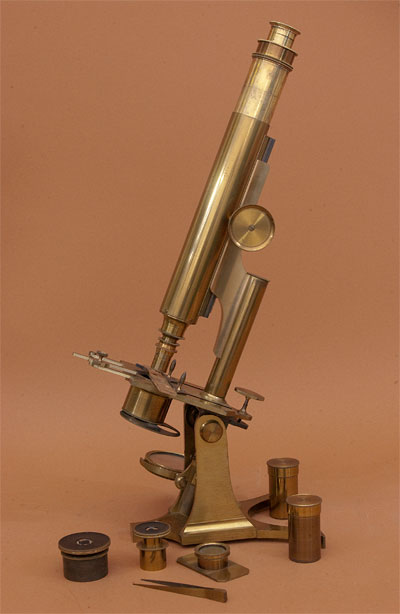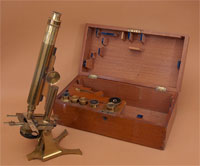 |
|||||
 |
 |
||||
 |
|||||
 |
 |
||||
Smith & Beck Best Student's Stand Microscope (No. 161) |
|||||||||
 |
Age: 1850 Made by: Smith & Beck Made in: England |
||||||||
 |
|||||||||
|
Smith & Beck
6, Coleman St London 911 |
|||||||||
 |
|||||||||
|
Mahogany Storage Case
|
|||||||||
| Microscope No. 161 in the Golub Collection is a large brass monocular microscope with a reversed claw-footed base made by the firm of Smith & Beck of London. This microscope design is Stand No. 3 or "Best Student's Stand" as described in Richard Beck's 1865 book "The Achromatic Microscope". James Smith (mathematical instrument maker) formed a company with Richard Beck in 1847. The firm "Smith & Beck" was based at 6 Coleman St, London. In 1851 Beck's brother Joseph joined the firm, and in 1857 it became "Smith, Beck & Beck". In 1864 James Smith retired and the company changed names again to became "R & J Beck". Both Smith and Beck had a connection to Joseph Jackson Lister. Richard Beck was Lister's nephew, whereas James Smith made lenses for Lister. Instruments like this one were so well made and regarded that the firm was awarded the Council Medal at the 1851 Great Exhibition.
This fine instrument is typical of that era of microscope manufacture in London. It is constructed entirely of brass, has a massive claw-shaped base, and pivots at the compass joint at the top of the base supports. The microscope body is supported by a cylindrical pillar, outside of which is a brass, spring-loaded sleeve that attaches to the body support. This sleeve can be moved incrementally up and down for fine focusing via a thumbscrew and a short-arm mechanism. Coarse focus is a more typical rack and pinion. The optics are more modern than is found earlier in the 19th Century, in that the Field lens has been incorporated into the Huygenian eyepiece. There are two objectives with this instrument: a 1 1/2 inch low magnification lens and a 1/5 inch high magnification lens. This latter objective has a correction collar (marked 0–9) and is engraved "Uncovered". Presumably this lens could be used without a coverslip. The stage incorporates an adjustible spring-loaded sample holder. Below the stage can be fitted either a three-position aperture wheel or a polarizer. When the polarizer is in place the included Analyzer could be fitted over the eyepiece so that the operator could investigate samples using Polarized Light Microscopy. There are two existing accessories: a brass live bix for viewing aquitic samples, and a brass forceps. Indentatios in the included mahogany storage case sugggest that there were several other accessories including a free-standing bullseye lens. The mahogany base is 43x30x16.5cm (tall), and the microscope itself is approximately 43cm tall. This microscope is serial number 911. For an interesting history of this firm click here. |
|||||||||
| Featured 10/2010 | |||||||||